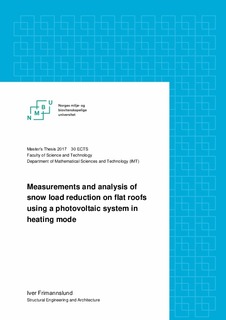| dc.contributor.advisor | Thiis, Thomas K. | |
| dc.contributor.author | Frimannslund, Iver | |
| dc.date.accessioned | 2017-11-06T13:45:12Z | |
| dc.date.available | 2017-11-06T13:45:12Z | |
| dc.date.issued | 2017 | |
| dc.identifier.uri | http://hdl.handle.net/11250/2464310 | |
| dc.description.abstract | Previous studies show that a large portion of the existing building stock in Norway is regarded as under-designed with respect to snow load. Unfortunately, few solutions are available for reducing heavy snow loads occurring on roofs to this date and building owners often rely on shoveling snow off the roof in a heavy snowfall scenario. The PV-heating system intends to be a modern solution for snow load reduction. The system functions by sending current back into the PV-modules, inducing a heat flow at the module surface, allowing for snow load reduction.
This thesis combines measurements and theoretical analysis to investigate the PV-heating system. The objective is to uncover how feasible a PV-heating system is for reducing snow loads in a sub-arctic climate. The measurements and analysis were performed with the specific intent to document the load reducing capabilities of a PV-heating system operating under varying climatic conditions. Different strategies for the snow load reduction are investigated. Melting the snow is the obvious way of reducing the load. Sublimation, the instant transition from solid to vapor, serves as an alternative to melting, conducive under different climatic conditions. Several experiments were performed, including the test of a full scale PV-heating system and a case study with single modules. Through additional research questions, the thesis also explores the system’s relation to current laws and design regulation, and if melting snow on the module surface can result in higher solar gains.
The results indicate that the potential of reducing snow loads with a PV-heating system is existent. Melting snow on the module surface is unproblematic, but the transportation of water from the roof surface can be challenging. The snow’s capability for water-saturation and the freezing of water at the roof can result in insufficient load reduction. A drainage system with heated gutters is recommended to ensure proper load reduction for the roof. Tests of sublimating the snow also showed potential. A sublimation amount of 0.86 kg/m2 per day was achieved during a case study in Nordmarka, Oslo. To truly uncover the potential of load reduction by sublimation, further research is recommended. An automation of the system, implementing live data measured on site and weather forecast, is considered advantageous to optimize ablation and save energy.
Melting snow on the module surface allows for enhancing solar gains during the winter season. This thesis weighs the energy used to melt the snow against the potential of producing energy during winter. The results of analysis and theoretical calculation are indicative of an existing potential of enhanced solar gains and a possible new application of the system.
The relation to the law and design regulations is also investigated to consider how the system can be implemented in existing and new buildings. The thesis concludes that further documentation of the system’s load reduction capabilities is needed to integrate the system into the design regulations and to establish of a legal precedent for the system. | nb_NO |
| dc.description.abstract | Tidligere studier viser at en større del av den norske bygningsmassen er underdimensjonert i forhold til snølast. Det finnes få løsninger for eiere av byggverk til å redusere snølasten. De fleste er avhengig av å måke snølasten fra taket når slike tunge laster inntreffer. Et solcellesystem i varmemodus sikter på å redusere snølasten for underdimensjonerte tak. Systemet fungerer ved å sende strøm tilbake til solcellepanelene, som derav utvikler varme. På denne måten sikter systemet på å kunne redusere snølasten på taket.
Oppgaven tar sikte på å dokumentere hvorvidt der er mulig å redusere tung snølast med et solcellesystem i varmemodus. Feltmålinger, beregninger og bakgrunnsteori er presentert i denne oppgaven med hensikt om å avdekke hvorvidt en slik snølastreduksjon lar seg gjøre. Feltmålingene er utført med hensikt om å smelte og sublimere snø fra solcellepanelene. Sublimasjon er når et fast stoff går direkte til gass uten å noen gang være i flytende fase. Ved å sublimere snø kan man slippe avrenningsproblematikken på taket. Feltmålingene inkluderer en snølastreduksjonstest av et ferdig installert solcellesystem som i varmemodus, samt et case-study med enkeltpaneler. I tillegg til å utforske hvordan snølasten reduseres optimalt forsøker oppgaven å gi svar på hvordan systemet passer inn med gjeldende lover og forskrifter om dimensjonering av tak. Oppgaven sikter også på å avdekke hvorvidt det er mulig å øke inntaket av solenergi ved å smelte snø på solcelleoverflaten. | nb_NO |
| dc.language.iso | eng | nb_NO |
| dc.publisher | Norwegian University of Life Sciences, Ås | nb_NO |
| dc.rights | Attribution-NonCommercial-NoDerivatives 4.0 Internasjonal | * |
| dc.rights.uri | http://creativecommons.org/licenses/by-nc-nd/4.0/deed.no | * |
| dc.subject | Photovoltaic | nb_NO |
| dc.subject | Snow load reduction | nb_NO |
| dc.subject | Melting | nb_NO |
| dc.subject | Sublimation | nb_NO |
| dc.subject | UAV | nb_NO |
| dc.subject | Thermography | nb_NO |
| dc.title | Measurements and analysis of snow load reduction on flat roofs using a photovoltaic system in heating mode | nb_NO |
| dc.type | Master thesis | nb_NO |
| dc.subject.nsi | VDP::Teknologi: 500 | nb_NO |
| dc.source.pagenumber | 157 | nb_NO |
| dc.description.localcode | M-BA | nb_NO |

